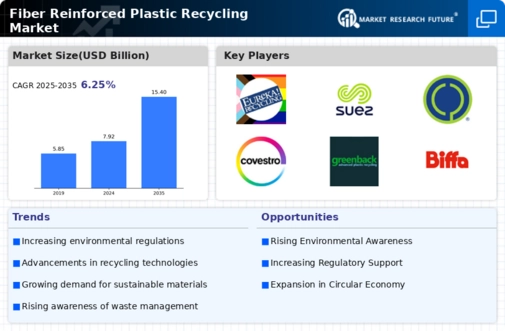Economic Benefits of Recycling
The economic benefits associated with recycling fiber reinforced plastics are emerging as a significant driver for the Fiber Reinforced Plastic Recycling Market. Recycling not only reduces the costs associated with raw material procurement but also minimizes waste disposal expenses. By reintroducing recycled materials into production processes, companies can achieve cost savings while contributing to sustainability efforts. Market analysis indicates that the recycling of fiber reinforced plastics can lead to substantial reductions in production costs, making it an attractive option for manufacturers. Furthermore, the potential for job creation in the recycling sector adds an economic dimension to this market. As the demand for recycled fiber reinforced plastics increases, the Fiber Reinforced Plastic Recycling Market is likely to expand, driven by both environmental and economic incentives.
Rising Environmental Awareness
Rising environmental awareness among consumers and industries is significantly influencing the Fiber Reinforced Plastic Recycling Market. As public concern regarding plastic pollution escalates, there is a growing demand for sustainable alternatives and recycling solutions. This shift in consumer behavior is prompting manufacturers to adopt more eco-friendly practices, including the recycling of fiber reinforced plastics. Market data suggests that companies that prioritize sustainability are likely to gain a competitive edge, as consumers increasingly prefer products with lower environmental footprints. Additionally, industries such as construction and automotive are under pressure to reduce their carbon emissions, further driving the need for effective recycling solutions. Consequently, the Fiber Reinforced Plastic Recycling Market is poised for growth as stakeholders respond to this heightened environmental consciousness.
Growing Demand from Key Industries
The growing demand for fiber reinforced plastics from key industries is a crucial driver for the Fiber Reinforced Plastic Recycling Market. Sectors such as automotive, aerospace, and construction are increasingly utilizing fiber reinforced plastics due to their lightweight and high-strength properties. This trend has led to a corresponding rise in the need for effective recycling solutions to manage the end-of-life products. As these industries strive to meet sustainability targets, the recycling of fiber reinforced plastics becomes essential. Market projections indicate that the demand for recycled materials in these sectors will continue to rise, further propelling the Fiber Reinforced Plastic Recycling Market. The integration of recycled fiber reinforced plastics into new products not only supports resource conservation but also aligns with the growing emphasis on sustainable manufacturing practices.
Technological Innovations in Recycling
Technological advancements in recycling processes are driving the Fiber Reinforced Plastic Recycling Market. Innovations such as advanced sorting technologies and chemical recycling methods enhance the efficiency of recycling operations. For instance, the development of automated sorting systems allows for the precise separation of fiber reinforced plastics from other materials, thereby increasing the purity of recycled products. Furthermore, chemical recycling techniques enable the breakdown of complex polymers into their original monomers, facilitating the creation of high-quality recycled materials. As a result, the market is witnessing a surge in the adoption of these technologies, which not only improve recycling rates but also reduce the environmental impact associated with fiber reinforced plastics. This trend indicates a promising future for the Fiber Reinforced Plastic Recycling Market, as companies increasingly invest in innovative solutions to meet sustainability goals.
Regulatory Frameworks Promoting Recycling
The establishment of regulatory frameworks promoting sustainable practices is a key driver for the Fiber Reinforced Plastic Recycling Market. Governments are increasingly implementing policies aimed at reducing plastic waste and encouraging recycling initiatives. For example, regulations mandating the recycling of fiber reinforced plastics in various sectors, such as automotive and construction, are becoming more prevalent. These regulations not only create a legal obligation for manufacturers to recycle but also incentivize investments in recycling infrastructure. As a result, the Fiber Reinforced Plastic Recycling Market is likely to experience growth as companies align their operations with these regulations. The increasing focus on circular economy principles further supports this trend, as businesses seek to minimize waste and maximize resource efficiency through effective recycling practices.

















Leave a Comment